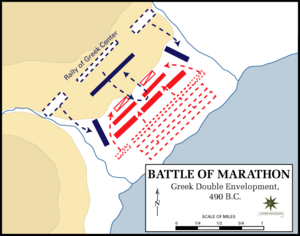Envelopment facts for kids
Envelopment is a clever military move. It means attacking an enemy army from its sides (called the flanks) or from behind (the rear). While one part of your army keeps the enemy busy from the front, another part sneaks around to attack where they least expect it. This makes the enemy fight in a direction they are not ready for.
For an envelopment to work, there must be a side of the enemy's position that can be attacked. Unlike a simple flanking move, envelopment uses the enemy's fixed position, any barriers, and the land itself to plan the attack. This tactic has both good points and bad points. A big advantage is that you can capture or defeat a large part of the enemy's army. It can also be less risky than some other attack plans. However, a disadvantage is that the enemy might launch a surprise attack on your army's middle or other side, where your forces might be weaker.
Different Kinds of Envelopment
There are several ways armies can use the envelopment tactic:
- Turning movement is when an army tries to "turn" the enemy away from their strong defensive spot. This forces them to move or react in a new way.
- Single envelopment means attacking just one side (flank) or the back of the enemy. At the same time, another part of your army keeps the enemy focused on their front.
- Double envelopment is also known as a Pincer movement. This tactic needs three groups of soldiers. One group holds the enemy's attention in the middle. The other two groups attack the enemy's left and right sides. Once these two attacking groups reach the enemy's rear, they surround the enemy completely.
- Vertical envelopment is an attack that comes from the sky! This idea was first thought of by Benjamin Franklin. However, it only became possible after the invention of the airplane. Vertical envelopment uses paratroopers or other soldiers who arrive by air. They land on the enemy's side or behind them, surprising them from above.
Famous Envelopment Battles
Many famous battles in history have used the envelopment tactic:
- Alexander the Great used a single envelopment at the Battle of Gaugamela in 331 BC.
- Robert E. Lee used this tactic during the Battle of Chancellorsville in 1863.
- During World War II, German General Erwin Rommel successfully used a single envelopment at the Battle of Gazala in 1941. This led to his capture of Tobruk.
- One of the most famous double envelopments was by Hannibal at the Battle of Cannae. He defeated the powerful Roman army in 216 BC.
- In 1781, during the American Revolutionary War, American general Daniel Morgan successfully used a double envelopment. He defeated British general Banastre Tarleton, causing many British soldiers to surrender.
- In 1944, during Operation Overlord, German troops were caught in a double envelopment. This happened in the Falaise Gap by British and American forces.


